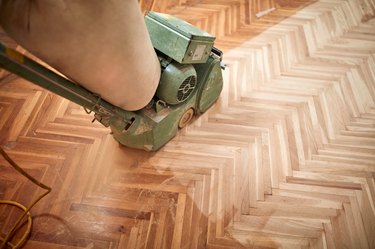
Things You'll Need
Absorbent material such as baking soda, baby powder or cornstarch
Broom
Dustpan
Cloths
Towels
Dry-cleaning spot remover
Soft-bristled brush
Oxalic acid
Distilled water
Microwave-safe glass jar
Microwave
Paintbrushes
Borax
Fine piece of sandpaper
Wood stain
Rag

Oil of any kind -- including cooking oil and baby oil -- spilled on your wood floors can leave unsightly dark spots. Wood quickly absorbs oil so dealing with the spill as soon as possible will reduce the chance of a possible permanent oil stain on your floors. You can remove fresh oil from your floors using a few common household items. However, once the oil has dried on the wood floors, getting oil stains out of wood floors requires bleaching, sanding and staining the wood surfaces.
Fresh Oil
Step 1: Using Absorbent Materials to Get Oil Stains Out of Wood Floors
Sprinkle an absorbent material -- such as baking soda, cornstarch or baby powder -- over the fresh oil.
Video of the Day
Step 2: Let it Soak
Let the absorbent material soak up the oil for 1 hour. Use a broom to sweep the absorbent material off the wood and into a dustpan.
Step 3: Wipe the Wood Flooring
Wipe the wood floor clean with a damp cloth and dry with a towel to finish getting oil stains out of your wood flooring.
Dried Oil
Step 1: Use Dry-Cleaning Fluid
Dampen the oil spot with two to three drops dry-cleaning spot remover. Scrub the spot remover gently into the wood with a soft-bristled scrub brush. Continue adding the dry-cleaning spot remover one drop at a time and scrubbing with the brush until the oil is no longer visible on the surface to get oil stains out of the wood floor. Continue, however, with the remaining steps if the oil stain is still present.
Step 2: Prepare Oxalic Acid
Pour one part oxalic acid and one part distilled water into a microwave-safe glass jar. Set the jar inside a microwave. Heat on high for 30-second intervals until the mixture is warm. You must keep the mixture warm during the bleaching process. Reheat for 30-second intervals until warm whenever the mixture cools.
Step 3: Apply the Oxalic Acid Mixture
Saturate a paintbrush in the mixture. Hold the paintbrush over the jar and let the excess mixture drip off. Apply the mixture to the oil stains in even brush strokes until the spot is thoroughly saturated. Let the bleach mixture dry on the wood floors.
Step 4: Heat and Brush
Continue heating the mixture and brushing it on the wood until the oil stains are no longer visible. Stop the bleaching process by rinsing the area with a neutralizing mixture of 1 gallon water and 3 oz. borax. Dip a cloth in the mixture and wipe the wood floors clean.
Step 5: Remove the Neutralizer
Wipe the neutralizing mixture off the wood floors with clean cloth dampened in cool water. Pat the excess moisture off the floors with a towel and let air-dry.
Step 6: Sand the Spot
Sand the bleached spot down with a piece of fine sandpaper. Oxalic acid has a tendency to raise the wood grain. Rub the fine sandpaper gently over the raised area for several passes. Rub with the wood grain until the raised area is level with the surrounding wood.
Step 7: Brush On Wood Stain
Brush wood stain on the bleached area. Use the same color stain to match the surrounding wood floors. Brush with the wood grain. Wipe the excess stain off the wood floor with a rag. Let the floor dry.
Tip
You can find oxalic acid -- also known as wood bleach -- at home improvement centers.
Video of the Day